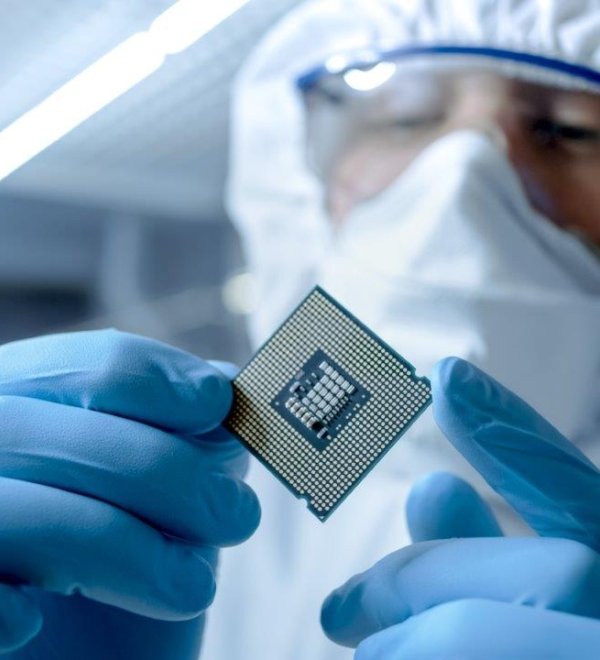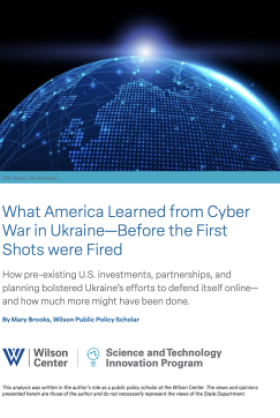
A blog of the Science and Technology Innovation Program
Event Summary | Looking Deeper: Investing in Science, Technology, and Resilience
Over a year out from the passage of the CHIPS and Science Act, we take a moment to reflect on what’s been achieved by this legislation as well as other historic federal legislation and investment, such as the Inflation Reduction Act, the Bipartisan Infrastructure Law, and the American Rescue Plan. These have heralded immense investment into not only semiconductor resilience, but also technological progress, clean energy and green infrastructure, access to broadband, and America’s entrepreneurial ecosystem.

STIP event

Looking Deeper: Investing in Science, Technology, and Resilience
Watch NowIntroduction
“There’s a lot of pent-up investment and demand that is ready to move forward to support the CHIPS Act,” observed Jimmy Goodrich, the vice president of Global Policy at the Semiconductors Industry Association. He noted, “The only challenge is that it is a global market. There are many other economies out there that have been doing industrial policy for a very long time, and they are very aggressive in trying to attract these semiconductor investments.”
It has been over a year since the passage of the CHIPS and Science Act, in which “Congress allocated $52 billion, $39 billion for manufacturing incentives and $11 billion for research and development” explained Fayrouz Saad, director of Public Engagement for the CHIPS Program Office at the Department of Commerce. The legislation has had a ripple effect on the domestic semiconductor industry. To understand the impact of this landmark bill, the Wilson Center’s Science and Technology Innovation Program launched Looking Deeper, a three-part series where panelists from across sectors came together to share their perspectives on the United States' investment in semiconductor resilience. This kickoff event was the first installation of the series, setting the scene for conversation about the CHIPS Act’s relation to export controls, how it ties to global supply chain issues, and conversations around subsidies.
Export Controls: Differing Perspectives
“We do have two broad areas of concern in this policy area. One is the domestic content requirements in the broader industrial policy space that we see as undercutting the idea of friend shoring,” said Jay Morgan, senior policy manager at the Representative of German Industry and Trade, adding, “Secondly, extraterritorial restrictions like the export controls implemented last October or the upcoming investments screening from the recent Executive Order can lead to a chilling effect on investment even within friendly, partner countries.”
The CHIPS Act fits into a broader body of legislation, such as the Inflation Reduction Act, the Bipartisan Infrastructure Deal, and the American Rescue Plan, signaling a commitment to invest not only in semiconductor resilience, but also technology innovation, clean energy, R&D, and American entrepreneurship. It optimizes existing policy by, for example, modifying export controls which regulate what technologies and data can be shared outside the United States. The CHIPS Act clarified language regarding embargos related to producing semiconductors impacting “countries of concern.” Morgan noted that before this change, many companies had lost business in the United States. because of the controls, such as one company that used chips to produce sensors for video game controllers.
While some modifications to export controls have been centered around loosening restrictions, other controls were set in place to prioritize supply chain security and quality concerns. One restriction loosened was investment guardrails, which were originally included in the legislation to curb American investment in China. The goal of such restrictions was to reduce reliance on other nations and to develop a domestic supply chain that is transparent and manufactures products that would be safe for the US government to use for national security. Another reason for stricter export controls was to divert investment away from countries and companies that don’t adhere to ethical labor standards, or which violate human rights.
Goodrich said that the most beneficial role that sanctions and other export controls can play is “ensuring that it's a level playing field and that everyone's working together to try and achieve a common objective in a way that doesn't unduly impact the innovation in the commercial sector.” Restrictions like these, such as the outbound investment screening rules that were also included in the CHIPS Act, prompted more concern from the industry, both domestically and abroad, that such regulations would lead to a chilling effect on investments from partner countries, potentially leading to supply chain disruptions.
With regard to China, it was a clear concern that the United States maintain a strategic advantage in intellectual property and national security. Per Goodrich, “When it comes to the export controls on China, obviously China has a complicated relationship with the United States... a more robust definition of national security is not surprisingly driving a counter strategy here in the United States.”
The Global Supply Chain
“The CHIP industry...is global from top to bottom... every aspect of the supply chain, every aspect of the manufacturing and chip design process is about as globalized as it can be,” said Goodrich.
Since 1990, America’s share of the semiconductor industry has fallen from 37% to just 12%. The resulting reliance on offshore production leaves the US supply chain vulnerable. To address this, the CHIPS Act aimed to reshore semiconductor manufacturing. Saad explained that the CHIPs Program Office at the Department of Commerce “laid out four goals; establish and expand domestic production of leading edge in semiconductors in the US, of which the US currently makes 0% of the world's supply, build a sufficient and stable supply of mature nodes semiconductors, invest in R&D to ensure the next generation of semiconductor technology is developed and produced in the US, and of course, create tens of thousands of good paying manufacturing jobs of more than 100,000 construction jobs.” Some argue that the extent to which production should be recentralized in the United States is still unresolved. The US government, and partners in industry, must decide between offshoring, onshoring, and friend-shoring.
Offshoring has been the trend in recent years because basing manufacturing and material sourcing overseas often has the advantage of lower costs, but as seen during the pandemic, creates a fragile supply chain. An alternative approach, onshoring, means developing the American semiconductor industry to keep production domestic and thus protect supply chain. This may not be ideal though. Morgan commented that completely domestic onshore supply chains risk a single point of failure, as happened with the 2022 infant formula shortage.
Morgan believed that friend-shoring, where the United States and its allies would work together to create a diversified supply chain, contributes to resilience. There is concern that the CHIPS Act may inhibit the growth of such trade networks; Morgan noted that “the domestic content requirements undercut the idea of friend shoring.” All three panelists agreed that a diverse supply chain was integral in maintaining competitive advantage with semiconductors. It would be impossible to unilaterally develop the infrastructure needed to manufacture semiconductor chips.
The Race for Subsidies
Initiatives like the US’s CHIPS Act or the joint EU-US Trade and Technology Council have raised concerns that a “race for subsidies” might damage the long-term sustainability of reshoring semiconductor manufacturing. Saad, stressed a key goal of the CHIPS grants and subsidies was to “build a sufficient and stable supply of mature nodes and semiconductors and invest in R&D to ensure the next generation of semiconductor technology is produced in the US.” To meet this goal, Saad said the CHIPS Program Office is making sure that “government subsidies are just a piece of the puzzle, only part of what is catalyzing the market.” She emphasized the US effort to specialize in some areas of semiconductor manufacturing and participate in friend-shoring for others could relieve the downward pressure on American wages and environmental standards while building a resilient supply chain.
Goodrich agreed that government investments like the CHIPS Act are just the first step, saying that “even though the government is incentivizing production, it’s still the private sector that’s undertaking the majority of the risk and making the majority of the investment.” Striking a balance between government investment towards national goals and market-based industry-driven innovation is critical to a sustainable semiconductor ecosystem was an emphasis of the panel.
The Future of the Industry: Workforce Development and Common-Sense Policy
As Morgan observed, “If you don’t have a workforce, very little production is going to happen.” Across the board, the event highlighted workforce development as essential to bolstering the semiconductor industry. Saad highlighted that a key piece of the CHIPS Act strategy was to create “tens of thousands of well-paying manufacturing jobs and more than a hundred thousand construction jobs.” Morgan hopes that the United States takes after countries that have successfully funded dual education programs, combining vocational education and apprenticeships, to meet the growing demand for skilled workers. He mentioned that various governments, like the United States and Germany, can benefit from “reducing bureaucratic burden on businesses” and “engaging in immigration reform to ensure they have a sufficient workforce in the future.” The workforce shortage is a considerable barrier to growing the semiconductor industry, a topic which panelists discussed in the second edition of Looking Deeper.
It will be imperative to find a balance between the diverse objectives of different stakeholders in the semiconductor manufacturing industry. As more regulations emerges, there is a growing tension between national security goals and the economics of competition. Experts like Goodrich agree, the key to navigating this situation is “transparent, effective, and predictable” policy.
About the Author


Science and Technology Innovation Program
The Science and Technology Innovation Program (STIP) serves as the bridge between technologists, policymakers, industry, and global stakeholders. Read more

Global Europe Program
The Global Europe Program is focused on Europe’s capabilities, and how it engages on critical global issues. We investigate European approaches to critical global issues. We examine Europe’s relations with Russia and Eurasia, China and the Indo-Pacific, the Middle East and Africa. Our initiatives include “Ukraine in Europe” – an examination of what it will take to make Ukraine’s European future a reality. But we also examine the role of NATO, the European Union and the OSCE, Europe’s energy security, transatlantic trade disputes, and challenges to democracy. The Global Europe Program’s staff, scholars-in-residence, and Global Fellows participate in seminars, policy study groups, and international conferences to provide analytical recommendations to policy makers and the media. Read more

Wahba Institute for Strategic Competition
The Wahba Institute for Strategic Competition works to shape conversations and inspire meaningful action to strengthen technology, trade, infrastructure, and energy as part of American economic and global leadership that benefits the nation and the world. Read more














